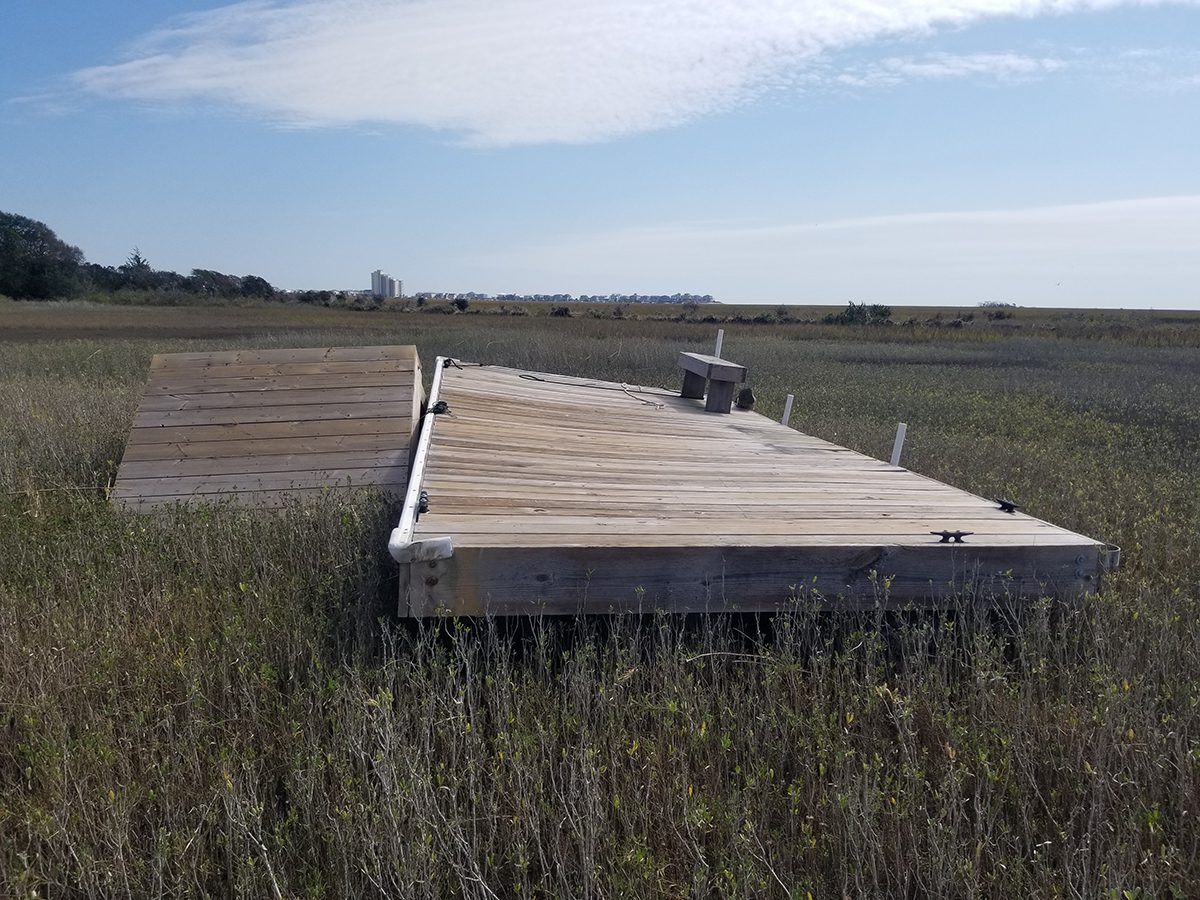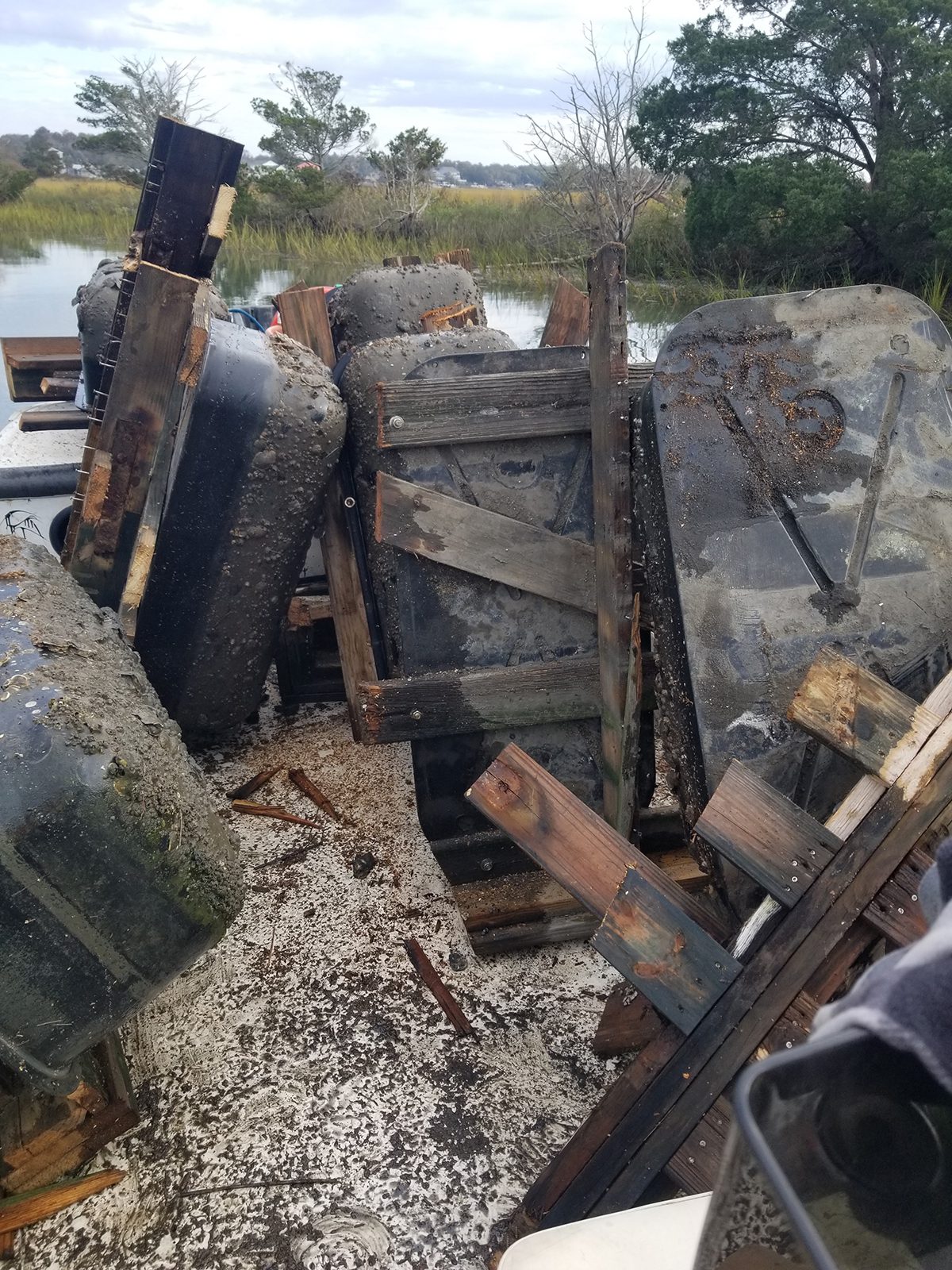
Joe Huie was not expecting this.
Sections of docks and roofs, lumber and handrails tossed by Hurricane Ian-driven waves and wind-littered soundfront shorelines in southern Brunswick County.
Supporter Spotlight
“This is the worst we’ve seen so far,” Huie said. The debris field scattered along sound banks back into marshlands from Brick Landing in Ocean Isle Beach to Sunset Beach was staggering, “for such a weak storm, to be honest.”
Huie and a small crew of fellow fishermen headed south from their base in Sneads Ferry four days after the Category 1 hurricane made landfall near Georgetown, South Carolina, a small town nearly 80 miles from Ocean Isle Beach.
Within three days, the crew filled a 40-yard dumpster with what they’d picked up so far.
Much of what is being removed makes the case that North Carolina needs to reinstate building codes for residential docks and piers and that property owners should thoroughly vet the contractors who build these waterfront structures, environmental stewards argue.
“Hurricane Ian provided a really good illustration of how persistent this kind of debris is, the docks and piers in our coastal wetlands,” said Kerri Allen, manager of the North Carolina Coastal Federation’s southeast regional office and coastal advocate. “This is a storm that really had minimal impacts to the North Carolina coast yet it still brought a tremendous amount of dock and pier-related debris.”
Supporter Spotlight
Huie’s crew have been removing debris for the past 3.5 years from coastal marshlands spanning from Swansboro south to Brunswick County.
On cleanup days, the crew collects about 1 ton of material a day. Their work is part of a broad-scale effort by various agencies and groups, including the Coastal Federation, to remove marine debris clogging coastal marshlands and clumping up on spoil islands. The Coastal Federation publishes Coastal Review.
These areas are largely tucked out of view from boaters skimming across sounds.
Until he was hired by the Coastal Federation to walk through marsh and remove debris, Huie said he never saw what lay scattered just beyond the shorelines of the New River.
“The debris we’re talking about is in the marsh and it’s everywhere in the marsh,” he said. “If you don’t get out and walk it, you don’t see it. We had no idea there was that magnitude of debris there.”
In the days following Hurricane Ian, he found an intact porch structure in an area of marsh near Sunset Beach.
“It’s very nice. The tags were still on the decking boards where it was built not too long ago,” Huie said.
Such a find is not unusual, or so debris removal crews have learned these last few years through the large debris removal program.
“That’s been something that’s been really startling for us is how many new structures that go into place that just aren’t up to par,” Allen said. “Unfortunately, there’s a number of contractors who purposely build subpar structures either to meet a price point or sometimes to keep themselves in business so it’s really important to do your research and find a contractor worth their salt who really knows the wave energy and engineers a structure that’s going to last.”

In 2020, the Coastal Federation partnered with government agencies, community groups and scholars to create the North Carolina Marine Debris Action Plan, one that focuses on cleaning debris and stopping it at the source.
One of the recommendations resulting from that plan is a push for stronger state building codes by reinstating rules pertaining to residential docks and piers.
“With all the awareness that has come about through the marine debris removal program we’re hoping to use that and lobby the North Carolina Building Code Council to put docks and piers back in and hopefully strengthen that language,” Allen said.
The council is a 17-member, governor-appointed board that adopts and amends state building codes.
A handful of local governments have amended their town ordinances in an effort to reduce marine debris by banning the use of unencapsulated polystyrene foam in the construction and repair of floating docks.
Wrightsville Beach earlier this month became the fourth town to ban the material. Over the summer, all three towns on Topsail Island added the ban.
The Coastal Federation’s work educating those beach towns about how much polystyrene litter has been found in coastal marshes has also made property owners aware of the issue, Allen said.
Funding for the cleanup came from a North Carolina General Assembly appropriation, the National Fish and Wildlife Foundation and the National Oceanic and Atmospheric Administration Marine Debris Program.
The Coastal Federation has applied for additional funding from the NOAA Marine Debris Program to launch a full-scale education and outreach campaign around the issue.
“I think the biggest takeaway for the coastal property owners is to really just choose their contractor wisely,” Allen said. “A dock that you build in Wrightsville Beach is going to be very different than one you building Emerald Isle because of the wave energy and location and environment. No one wants to be rebuilding their dock after every major storm and so by investing a little bit more research and sometimes money upfront they’re going to have a structure that’s going to last many years longer and also not end up as marine debris on our coast.”
Allen said the federation is in the process of developing a cost-benefit analysis to give property owners an idea of the difference in costs to build a dock or pier designed to last several years through multiple storms versus those that may be damaged or destroyed in one storm.
“In general, the individual components range from about 30% to 100% more expensive in what we’ve seen,” she said.
Staff are also exploring insurance incentives where insurance companies reward customers who have better built structures by lowering their rates.
In the meantime, the Coastal Federation plans to post a brochure on its website that will give property owners tips on how to find reputable contractors and what to consider when determining the best type of structure for the area in which it is to be built.
“Really it’s making sure that you both understand what the specific conditions are at the site of your dock and making sure that they are building a structure that is going to fail at a point that you both agree on,” Allen said.
Huie said he’s concerned about marine debris from larger, more powerful storms than Hurricane Ian.
“I’m just really worried what would happen if we had a Category 2 or Category 3,” he said. “It would take us years to clean up. It may alter some of the habitats forever just from the debris.”







